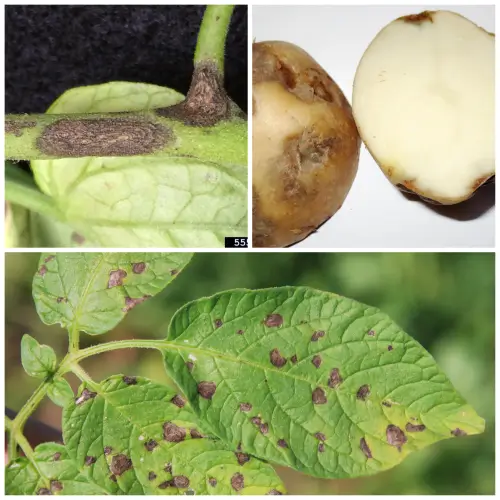Understanding Potato Early Blight: Causes, Symptoms, and Control Measures
Publish Date: 2024-12-29
Potato early blight is a common and destructive disease caused by the fungal pathogen Alternaria solani. While less infamous than late blight, it can still cause significant yield losses, especially under favorable environmental conditions. This article explores the causes, symptoms, and strategies for managing early blight in potato crops.

What is Potato Early Blight?
Early blight is a fungal disease that affects potatoes, tomatoes, and other members of the Solanaceae family. Despite its name, the disease can occur at any stage of the plant's growth. Early blight weakens plants by damaging their foliage, stems, and sometimes tubers, reducing both yield and quality.
Causes of Early Blight
The primary cause of early blight is the fungus Alternaria solani, which survives in plant debris, soil, and infected tubers. Here are the key factors contributing to its development:
- Infected Plant Debris: The pathogen can persist in dead leaves and stems, serving as a source of infection for subsequent crops.
- Airborne Spores: A. solani produces spores that spread through the air, especially during windy and humid conditions.
- Favorable Weather: Warm temperatures (24–29°C) combined with high humidity or dew favor the rapid growth and spread of the fungus.
- Weak Plants: Plants under stress due to nutrient deficiencies, drought, or other factors are more susceptible to infection.
Symptoms of Early Blight
Early blight symptoms typically begin on older leaves and gradually spread to other parts of the plant. Recognizing the early signs is essential for effective management.
Foliage Symptoms
- Small, dark brown to black spots appear on older leaves.
- Spots enlarge into circular lesions with characteristic concentric rings, resembling a "bull's eye."
- A yellow halo often surrounds the lesions, and affected leaves may wither and die.
- Severe infections lead to defoliation, exposing tubers to sun damage and reducing yield.
Stem Symptoms
- Dark, elongated lesions may form on stems, causing girdling and weakening of the plant.
Tuber Symptoms
- Infected tubers develop dry, dark, sunken spots on the surface.
- Lesions may extend into the flesh, forming corky, dry rot.
- Secondary infections by other pathogens can worsen the damage.
The Disease Cycle
The early blight pathogen follows a straightforward cycle:
- Overwintering: The fungus survives in infected plant debris or soil.
- Spore Production: During favorable conditions, spores form on infected plant material.
- Infection: Spores spread to healthy plants through wind, rain, or irrigation. They germinate and penetrate plant tissues, causing lesions.
- Secondary Infection: Spores produced on infected plants spread the disease further, compounding the damage.
This cycle can repeat multiple times during the growing season.
Management Strategies for Early Blight
Managing early blight requires a combination of cultural practices, resistant varieties, and chemical control. Here are the most effective approaches:
1. Cultural Practices
- Crop Rotation: Avoid planting potatoes or tomatoes in the same field for consecutive years.
- Sanitation: Remove and destroy infected plant debris after harvest to reduce overwintering fungal spores.
- Irrigation Management: Use drip irrigation to minimize leaf wetness, and water early in the day to allow leaves to dry quickly.
- Optimize Nutrition: Ensure adequate potassium and nitrogen levels to improve plant health and resistance.
2. Resistant Varieties
Select potato varieties that show resistance to early blight. Although resistance is not absolute, these varieties can significantly reduce the severity of infection.
3. Fungicide Applications
- Use protective fungicides, such as chlorothalonil or mancozeb, to prevent infection.
- Systemic fungicides like azoxystrobin or difenoconazole can control existing infections.
- Fungicides should be applied early in the season, especially during periods of warm, humid weather. Always follow local regulations and rotate fungicides to prevent resistance.
4. Monitoring and Early Intervention
- Regularly inspect fields for early symptoms of infection.
- Use disease forecasting tools to determine the best timing for fungicide applications.
Economic and Environmental Impact
While early blight may not always cause total crop failure, its impact on yield and quality can result in significant financial losses. Additionally, reliance on chemical controls raises concerns about environmental sustainability. Integrated pest management (IPM) practices can help reduce the environmental footprint while maintaining productivity.
Conclusion
Potato early blight is a manageable disease if addressed promptly and with a comprehensive strategy. By adopting proper cultural practices, planting resistant varieties, and applying fungicides judiciously, farmers can minimize losses and maintain healthy potato crops. Regular field monitoring and an understanding of the disease’s biology are critical for long-term success.
References:
This article is based on general agricultural knowledge and original research. Always consult local agricultural extension services for region-specific guidance.